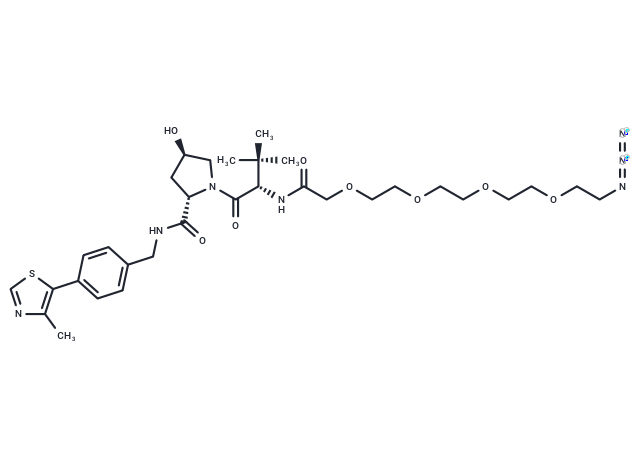Shopping Cart
- Remove All
 Your shopping cart is currently empty
Your shopping cart is currently empty

(S,R,S)-AHPC-PEG4-N3 (VHL Ligand-Linker Conjugates 5) is a synthesized ligand-linker for E3 ligase-based systems, comprising the (S,R,S)-AHPC VHL ligand and a 4-unit PEG linker, commonly used in PROTAC technology.

| Pack Size | Price | Availability | Quantity |
|---|---|---|---|
| 1 mg | $30 | In Stock | |
| 2 mg | $40 | In Stock | |
| 5 mg | $64 | In Stock | |
| 10 mg | $93 | In Stock | |
| 25 mg | $156 | In Stock | |
| 50 mg | $255 | In Stock | |
| 100 mg | $455 | In Stock |
| Description | (S,R,S)-AHPC-PEG4-N3 (VHL Ligand-Linker Conjugates 5) is a synthesized ligand-linker for E3 ligase-based systems, comprising the (S,R,S)-AHPC VHL ligand and a 4-unit PEG linker, commonly used in PROTAC technology. |
| In vitro | E3 ligase Ligand-Linker Conjugates 4, in combination with JQ1, induces the intracellular degradation of BET proteins[1]. |
| Alias | VHL Ligand-Linker Conjugates 5, VH032-PEG4-N3, E3 ligase Ligand-Linker Conjugates 4 |
| Molecular Weight | 689.83 |
| Formula | C32H47N7O8S |
| Cas No. | 1797406-81-5 |
| Smiles | C([C@@H](NC(COCCOCCOCCOCCN=[N+]=[N-])=O)[C@@](C)(C)C)(=O)N1[C@H](C(NCC2=CC=C(C=C2)C3=C(C)N=CS3)=O)C[C@@H](O)C1 |
| Relative Density. | no data available |
| Storage | keep away from direct sunlight | Powder: -20°C for 3 years | In solvent: -80°C for 1 year | Shipping with blue ice. | ||||||||||||||||||||||||||||||
| Solubility Information | DMSO: 45 mg/mL (65.2 mM), Sonication is recommended. | ||||||||||||||||||||||||||||||
Solution Preparation Table | |||||||||||||||||||||||||||||||
DMSO
| |||||||||||||||||||||||||||||||

Copyright © 2015-2025 TargetMol Chemicals Inc. All Rights Reserved.